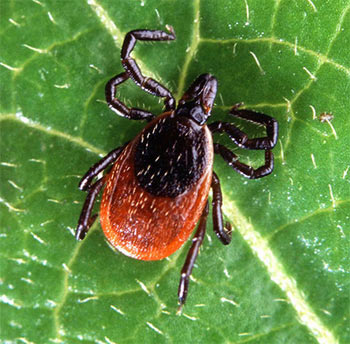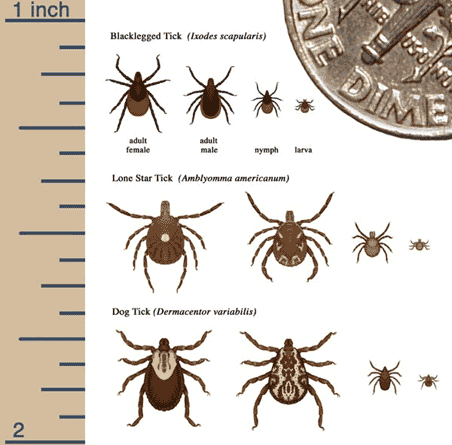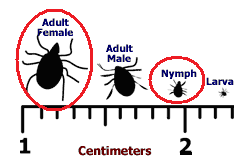The Vector
Borrelia burgdorferi is predominantly found in a species of hard ticks known as Ixodes scapularis, more commonly known as the "deer tick" or the "blacklegged tick." Female I. scapularis have a red-orange body with a black dorsal plate behind the mouthparts, and are about 3-3.7 mm long (about the size of a sesame seed).

The illustrations below indicate the relative sizes of the male and female adults and the nymph and larva stage.


Source: http://www.cdc.gov/ticks/life_cycle_and_hosts.html
The males are slightly smaller than the females and mostly black. Only nymph-stage and adult female deer ticks transmit the causative agent of Lyme disease to humans. An unfed adult female Ixodes scapularis is shown above to the left. (Source: Multipleorganisms.net). Female deer ticks become much larger when engorged with blood and can be confused with American dog ticks.
Only deer ticks (blacklegged ticks) carry the bacteria responsible for Lyme disease. Other tick species (e.g., American Dog ticks, Brown Dog ticks, and Lone-Star ticks) do not carry Borrellia burgdorferi, although they can transmit other diseases. Dog ticks carry the ricketsiae responsible for Rocky-Mountain Spotted Fever, which exists primarily in the Southwestern US and occasionally in Massachusetts. It is also important to note that the bite of a deer tick does not always result in Lyme disease. The probability of disease depends on how long the tick is attached, since longer attachment provides more opportunity to disgorge a sufficient number of bacteria. An infected tick must be attached for about 24-48 hours for the host to become infected. Consequently, ticks should be removed as soon as possible when they are found to be attached.
The Life Cycle of Deer Ticks
The life cycle of the deer tick in the northeastern United States is usually around two years, and consists of four stages:
- Egg
- Larva- a 6-legged form that feeds on birds, mice, and other rodents; active in late summer
- Nymph- an 8-legged from that feeds on birds, opossums, squirrels, cats, dogs, and humans; active in the spring and summer
- Adult- feeds mainly on deer and humans; active in the fall

Source: http://www.cdc.gov/ticks/life_cycle_and_hosts.html
"Blacklegged ticks live for two years and have three feeding stages: larvae, nymph, and adult. Tick eggs are laid in the spring and hatch as larvae in the summer. Larvae feed on mice, birds, and other small animals in the summer and early fall. When a young tick feeds on an infected animal, the tick takes bacteria into its body along with the blood meal, and it remains infected for the rest of its life. After this initial feeding, the larvae become inactive as they grow into nymphs. The following spring, nymphs seek blood meals in order to fuel their growth into adults. When the tick feeds again, it can transmit the bacterium to its new host. Usually the new host is another small rodent, but sometimes the new host is a human. Most cases of human illness occur in the late spring and summer when the tiny nymphs are most active and human outdoor activity is greatest. Adult ticks feed on large animals, and sometimes on humans. In the spring, adult female ticks lay their eggs on the ground, completing the life cycle. Although adult ticks often feed on deer, these animals do not become infected. Deer are nevertheless important in transporting ticks and maintaining tick populations."
Relative abundance of the three major tick stages during the year.

Source: Connecticut Tick Management Handbook)
 |
Deer Ticks and Lyme Disease Drag the items from the bottom to the slots on the right. |
|
This content requires JavaScript enabled.
|
|



